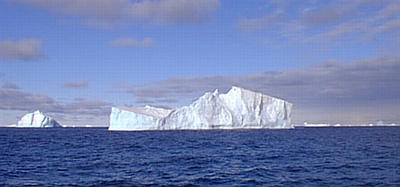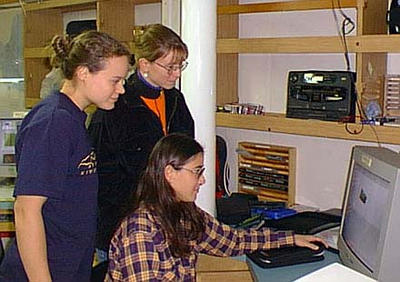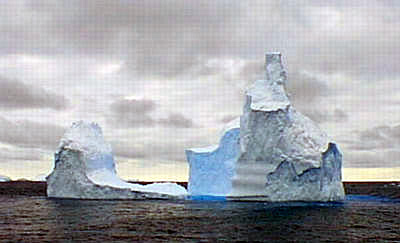
|
|
13 March, 1999
March 13, 1999
Hello from the Nathaniel B. Palmer! What a beautiful day we had today. It
started out very gray -- much like all of the other days throughout the
past few weeks. But the abundance of icebergs along today's transit was
awesome, and everyone kept running outside to take pictures even though the
sky wasn't very inviting. After lunch, the sun broke through! We actually
saw some blue sky, and the still abundant icebergs made it even more
gorgeous. It was amazing. We are in one of several areas around
Antarctica nicknamed "iceberg alley." We have driven past hundreds and
hundreds of icebergs that are lined up nearly parallel to the continent.
Many of the icebergs that we are seeing calved off the Ronne Ice Shelf in
the Weddell Sea (on the other side of the peninsula). Winds and ocean
currents have moved the icebergs around the peninsula to this side and
concentrated them in this narrow zone. Although they begin their lives as
tabular bergs (flat on top), the waves, storms, and warmer surface waters
have broken them into smaller pieces . . . resulting in the spectacular
shapes that we saw today.
I wanted to take some time to introduce you to the rest of the scientists
on the night shift. The journal on March 8 featured Julia, the scientist
in charge of the night shift. The other scientists are Diane Winter,
Tamara Misner, and Hannah Campbell. Diane is from Lincoln, Nebraska. She
graduated from Lincoln East High School in 1986; and attended the
University of Nebraska, where she received her B.S. in Biology in 1990.
She continued at the University of Nebraska to work on her M.S. in Geology,
which she received in 1995. In her research, she investigated three cores
from Antarctica -- two from the dry valleys and one from the ocean in front
of the dry valleys. Specifically, she was looking at the diatoms in the
core sediments. Diane has now started working on her Ph.D. at Florida
State University in Geology. While she was working in the Antarctic
Research Facility at Florida State, she met Dr. Anderson. All Antarctic
cores are stored at this facility, and he had traveled to Florida to
investigate the cores that we took while we were in Antarctica last winter.
Diane is here as a result of that encounter, and she is very happy that she
was able to come with us to Antarctica. In her spare time, she enjoys
knitting, reading, and baking. She also enjoys watching people . . . and
singing "off-key."
Tamara Misner is from Omaha, Nebraska. After graduating from Omaha
Westside in 1990, she began attending Gustavus Adolphus College in
Minnesota. She later transferred to the University of Nebraska, and
graduated in 1998 with a B.S. in Geology and a minor in Biology. Tamara
met Dr. Anderson this past summer while learning how to use some seismic
equipment. After that, she began working for him in the lab at Rice
University. Dr. Anderson was very impressed with her abilities, and she
was asked to come and work on this trip to Antarctica. She is really glad
to have the opportunity to study science in such a neat environment.
Tamara is currently living in western Pennsylvania, and she hopes to begin
graduate school, studying geology, within the next year or two. She enjoys
parcticipating in a Chinese internal style martial art called Tai Chi Chuan.
Tamara also enjoys hiking, biking, and camping.
Hannah Campbell grew up outside of Baltimore, Maryland. She has five
sisters and one brother, and she graduated from Woodlawn High School in
1995. When she first arrived at Rice University, she was majoring in both
Biochemistry and French studies. After taking a course titled "Geology of
National Parks," Hannah decided that she really liked geology. She took
several more geology classes, and eventually changed her second major from
Biochemistry to Geology. She was working in a carbonate sedimentology lab
in the geology department when she found out about Dr. Anderson's trip to
Antarctica. She is really excited that she was able to come along, and
will be using some of the data that we have gathered for her senior
research project on the timing of glaciation in the Ross Sea. Hannah
enjoys being outside, and likes mountain and road biking. She also likes
playing soccer and listening to live music. During the fall semester of
next year, Hannah will be traveling to Madagascar with the School for
International Training. She will be studying conservation and tropical
ecology in the rain forests of Madagascar. She is now a senior at Rice
University, and will graduate in May of 2000.
Today, we crossed from the Amundsen Sea into the Bellingshausen Sea.
Yesterday's question was: "Who was Thaddeus von Bellingshausen?" There is
some discrepency, according to the history books, as to who was the first
person to actually see the continent of Antarctica. Some say that it was
the American sealer, Nathaniel Brown Palmer. Others say it was the English
naval captain, Edward Bransfield. Still others say it was the Russian
captain, Thaddeus von Bellingshausen. Bellingshausen was a captain in the
Imperial Navy, and led the first Russian circumnavigation of the globe in
1803-1806. He really admired the travels of Captain James Cook, who was
the first person to travel south of the Antarctic Circle. Czar Alexander I
asked Bellingshausen to lead a journey south, with a dual purpose of
expanding the work done by Cook in the Southern latitudes and sailing as
far south as possible toward the Pole. His two ships crossed the Antarctic
Circle on Januaray 26, 1820. This was the first time that the Antarctic
Circle had been penetrated since Cook in 1773. Bellinghausen's log books
record that he reached a position of 69 degrees 21 minutes South and 2
degrees 14 minutes West -- which would have put him within 20 miles (and
sight) of land. Twelve days later, his logs indicate that he was even
closer to the continent. His record books, however, don't indicate that he
actually saw land. Perhaps he didn't recognize the ice-covered terrain as
being land and not icebergs. Maybe he expected to see trees and
vegetation. At any rate, it is thought that he is the first person to see
the continent . . . even though he probably didn't recognize his own
accomplishments.
Tomorrow will be another transit day. We are traveling at about ten or
eleven knots . . . but we have to travel about 400 more miles. That means
36 to 40 more hours before we arrive at Eltanin Bay. We are going to stop
there and do a short study before continuing up to Marguerite Bay. When we
were looking at Diane's biography, it was mentioned that she studied
diatoms found in sediments from the dry valleys. What are the dry valleys?
We'll look at that in tomorrow's journal. Until then . . .
Kim Giesting
Latitude: 70 degrees, 24 minutes South
Longitude: 100 degrees, 56 minutes West
Temperature: -3.6 degrees C
Barometer: 967.8 mb
Wind Speed: 4.8 knots
Wind Direction: 139 degrees (from the Southeast)
Sunrise: 06:33
Sunset: 19:34

In the afternoon, the sun came out! That made the icebergs all the more beautiful.

Hannah, Diane, and Tamara are watching the multibeam image on the computer.

We saw lots of neat icebergs today. They were all different shapes and sizes.
Contact the TEA in the field at
.
If you cannot connect through your browser, copy the
TEA's e-mail address in the "To:" line of
your favorite e-mail package.
|
